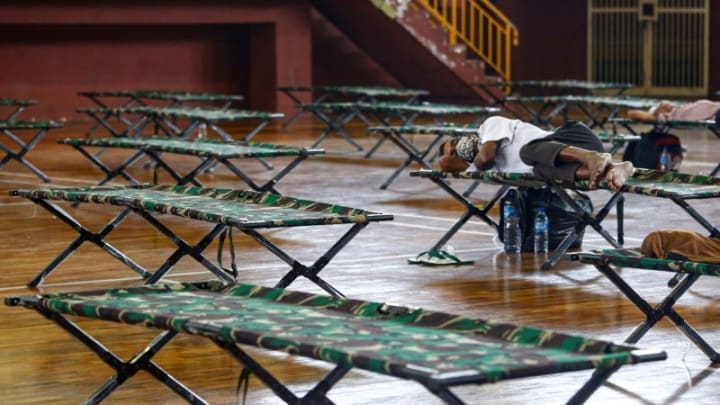“Stay at home, save lives” has emerged as a mantra in the fight against the coronavirus worldwide, underscoring how central the home is to public health during a pandemic that, incredibly, has put about one-third of the world’s population on lockdown so far. Housing conditions can literally mean the difference between life and death.
This is especially true in urban settings. Cities are diverse, dynamic, and dense, posing special challenges when extreme social-distancing measures are put into place — particularly for people living in informal settlements and those who have no place to call home at all.
The virus is already wreaking havoc on cities with large numbers of people experiencing homelessness — from New Delhi, where crowded shelters are struggling to follow social-distancing and sanitation guidelines, to New York, a COVID-19 hot spot with overwhelmed medical facilities and nearly 70,000 people who are homeless. Meanwhile, confirmed cases of the virus in cities that host some of the world’s most densely populated informal settlements — from the Kibera section of Nairobi to the favelas of Rio de Janeiro — have put public health officials on high alert.
Manila, where I work to reform housing policy on behalf of Habitat for Humanity, has been under a stay-at-home order for several weeks now in an attempt to slow the spread of COVID-19. Our metro area has thousands of people who are homeless, and roughly 3 million people reside in informal settlements.
The typical household in those slums has five to seven people squeezed into makeshift structures whose floor area averages roughly 5 meters by 6 meters. The World Health Organization’s guidelines call for 1 meter of distance between individuals in homes with suspected or confirmed COVID-19 cases. But that guidance is extremely hard, if not impossible, to follow in slum housing. This, along with poor air quality and houses with inadequate ventilation, makes informal settlements particularly vulnerable to the virus.
A containment policy that ignores slums is overlooking a massive group of people who, as COVID-19 tightens its grip on urban economies, are not only vulnerable themselves but can spread the virus to and from their homes as well, if forced to go out in search of ways to support their families.
Time is running out for megacities around the world to find solutions, but a few promising ones are beginning to take hold. Here in Manila, for example, a university closed to students is now housing people who have no place to call home. Even a shuttered ice cream shop has opened its doors to those with nowhere to sleep.
Some local governments have set up sleeping tents in sports complexes to accommodate people who are homeless. Others are considering partnering with hotels and inns that have empty rooms during the crisis — an approach also being pursued from London to Los Angeles. The state of California has already secured 7,000 hotel rooms that will be made available to people who don’t have a home during the crisis.
In slum areas, it is critical that we recognize how difficult social distancing can be. That is why we must prioritize testing for COVID-19 and proactively test individuals who have been in contact with any confirmed carriers of the virus, even when these individuals are not exhibiting symptoms. This, coupled with a system for isolating people who exhibit symptoms and who test positive, can help prevent the spread of infection. Given the condition of housing in slums, self-isolation is nearly impossible. The key here is to establish isolation facilities for individuals who do not have the resources to do so.
To ease the burden on health care systems, especially for countries that lack resources, this means converting government buildings, conference and exhibition facilities, hotels, military barracks, and even ships into quarantine facilities. Partnership with the private sector is pivotal in doing this. The Philippine government, for one, partnered with corporations across different sectors to help transform convention centers and national sports complexes into quarantine facilities. Local government units in the country are also forging similar partnerships to improve care capacity.
As we continue to use housing as a primary shield against COVID-19, a critical final element involves renters and homeowners who may struggle to pay rent and mortgages as economies wilt and job losses mount. Many will face eviction or the loss of their homes. The International Labour Organization says that 38% of the global workforce has employment that is vulnerable during the crisis.
Governments need to help assure that families can stay in the homes they have, so we don’t end up with even more people out on the streets or in substandard shelter. This means policies that prohibit eviction and foreclosures during a quarantine and that provide rent relief for those who were not able to earn within that period. Hard-hit countries also need to explore grace periods for mortgage payment, especially for households that have lost significant income.
Support for renters and mortgage owners must also be accompanied with assistance to landlords and financing institutions, as they will also have difficulty meeting their own financial obligations. Clearly, the whole housing sector must come together to ensure that people have the space needed to fight this pandemic.
In the meantime, as the virus continues to spread around the world, we need to find creative ways to bring essential services — food, medicine, and health care — to people’s doorsteps so they do not crowd into supermarkets and pharmacies. Some local governments in metro Manila, for instance, have implemented mobile supermarkets to reach the most vulnerable.
Once we emerge from this crisis, we need to acknowledge the disparities in housing and add urgency to the movement to create adequate, safe, and secure housing for all. The consensus among experts in infectious diseases, after all, is that the COVID-19 pandemic is not going to be the last of its kind.
Let’s hope that the next time a deadly virus with no cure threatens humanity, millions more people in cities around the world have a decent place to call home. Only then will our chances of preventing a pandemic be decent, too.
Source: devex.




